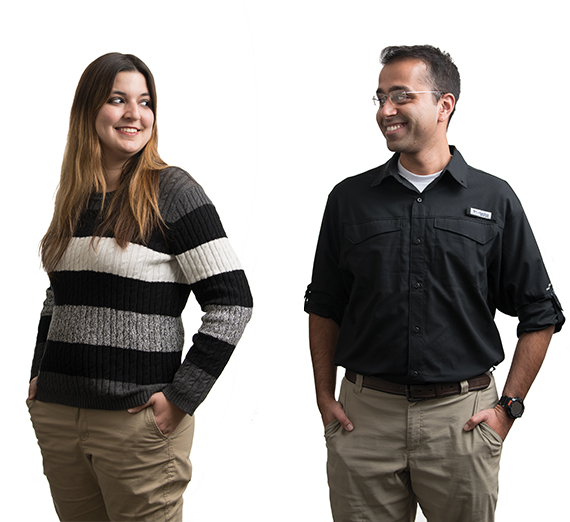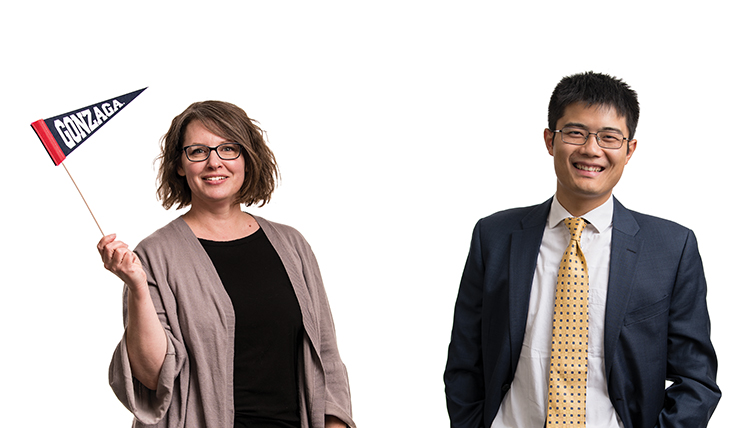New Faculty Spotlight: Fall 2018

New faculty members Dr. Shannen Cravens and Dr. Harman Khare
By Madeline Hueske ('19)
Several new faculty members arrived at the university this fall, adding their expertise to programs already rich with knowledge. GMag asked four of them a few questions.
The DNA Doctor
Shannen Cravens, Ph.D. – College of Arts and Sciences
A former professor at the University of Pennsylvania, Cravens seeks to understand the development of diseases through the study of proteins, especially those involved in turning on/off certain genes, and those used in DNA repair.
If you could create a class on your very favorite subject, what would it be? It would be called DNA Damage and Repair: Pathways for Targeted Cancer Therapy. I have long been fascinated by how our cells repair our DNA and protect us from the onset of numerous diseases. Developing this course would involve an exploration of the historical, current and potential future use of the proteins involved in specific forms of DNA repair as a therapeutic platform. I find it fun to dig down into the chemical details of medicine to truly appreciate how certain treatments work and how they’ve evolved from older, less effective practices.
How would students describe your teaching style? I run an interactive classroom with enthusiasm. I’m not a fan of talking at a class for long stretches of time – it’s more fun to have a dialogue running throughout each session. I firmly believe students learn much more when they are actively engaged.
When did you know you wanted to study and practice in this field? I developed a passion for chemistry as a sophomore in high school – that was the first time I was exposed to the topic in detail. I had a fantastic teacher and my experience in her class really resonated with me. My decision to specialize in biochemistry/biophysics came about when I was an undergraduate majoring in chemistry. I began research as a freshman in a lab that studied how a cancer drug (actinomycin D) could “read” our DNA. I was completely enthralled and decided to follow that passion in graduate school.
Who inspires you? I’ve been very fortunate to be surrounded by many strong, female scientist role models. When I think back on who played the biggest roles in setting me on my career path, there are two people that come to mind. My high school chemistry teacher, Marjan Faridpak, helped me discover my love for chemistry. I still keep in touch with her all these years later and visit her whenever I’m in southern California. Tammy Dwyer was my undergraduate research adviser at the University of San Diego and she has probably been my biggest inspiration. Working in her lab all four years of college really changed my career trajectory.
What book is on your nightstand? A sketchbook! I read quite a lot when I’m working on research projects or prepping lectures, so I find it more relaxing to step away from words for a bit. Drawing has been a hobby of mine since I was a child. When I have some downtime, I grab my sketchpad and dabble a bit in cartooning or realistic human portraits.
Chief Tinkerer
Harman Khare, Ph.D. – School of Engineering and Applied Science
Formerly from the University of Pennsylvania, Cravens is his fiancée. An expert in the field of tribology – an interdisciplinary approach to engineering that studies surfaces in relative motion. Hopes to use tribology to improve global energy efficiency and sustainability.
If you could create a class on your very favorite subject, what would it be? Automotive Tribology. We often don’t think about it, but there are hundreds of these interfaces in an automobile (the piston, camshaft or axle bearings). Advances in tribology are important for better fuel economy, reduction in greenhouse emissions and longevity of components. This course would cover fundamental principles in tribology, which itself is a fairly diverse field, but applied to various aspects of vehicular systems such as engine components and the powertrain.
How would students describe your teaching style? My teaching is heavily focused on student engagement and participation. A key part is learning-by-doing. Being trainee engineers, it is important that my students can take concepts they learn in the classroom out to the real world to create innovative and functional products.
When did you know you wanted to study and practice in this field? From an early age, my father encouraged me to develop a ‘tinkering’ mindset and to learn as much from building things as from taking them apart. Most importantly, I learned from him the value in carefully observing the physical world around us: to question why things work the way they do and (try) to propose rational solutions for when they don’t.
Who inspires you? I contribute nearly all my early inspiration to my father, who also happens to be a professor of mechanical engineering.
What book is on your nightstand? Crash Course by Paul Ingrassia. In the author’s own words, is something of a memoir on ‘The American Automobile Industry’s Road from Glory to Disaster,’ from the auto industry’s inception with the Model T, through the recession into early 2010s.

Wizard of Nerves
Starla Meighan – School of Nursing and Human Physiology
One of just two women working in the Human Physiology department, Meighan comes from Washington State University. She is a neuroscientist, but is fascinated by nearly all kinds of science related to the human body.
If you could create a class on your very favorite subject, what would it be? I am very fortunate that I have done this, twice. The first course, Death Defining, initially grew out of a discussion about whether we are certain with the tests we currently have that someone is absolutely brain dead. Ultimately the class became an exploration of just about every topic concerning death. The second course, Move, Think, Focus, was on a subject I had studied since graduate school, nervous system plasticity. A defining functional feature of our nervous systems is that they change function with input. Pretty much anything our senses bring in that is deemed “important enough” (emotionally charged events or something we practice repetitively) can alter our nervous system structure and function.
How would students describe your teaching style? My favorite descriptions over the years have been “makes scary topics fun” or “makes topics interesting that I didn’t think I’d be interested in.” I still do quite a bit of lecture, but you are likely to see a snippet of The Wizard of Oz to see a slow myotatic reflex or experience a variety of media forms and activities to help make things memorable.
When did you know you wanted to study and practice in this field? For a long time I wanted to be an archeologist/paleontologist/primatologist. We had an enormous National Geographic collection at my high school, and I spent my lunch periods looking through them. I’ve always had this propensity for wanting to find out more of what I didn’t know about and what none of us know about yet. But it was a lecture I saw on the lac operon in a genetics class as an undergraduate that opened my mind to teaching. It was a beauty in colorful chalk on four blackboards and the first time I ever remember seeing a cellular process and realizing stuff went on inside cells that made sense.
Who inspires you? I suppose I could say someone like Jane Goodall (my early inspiration for primatology and scientific inquiry) or anyone else so dedicated and driven to explore that they are willing to step way outside of norms and comfort zones
What book is on your nightstand? My nightstand is basically a bookshelf, but here are a few that I have been reading on most recently:
The Soul of an Octopus by Sy Montgomery
The Lives of a Cell by Lewis Thomas
How to Write Short Stories by James Scott Bell
Apostle of Finance
Yelin Zhang, Ph.D. – School of Business Administration
Coming from Schulich School of Business in Toronto, Zhang wants to incorporate math into finance classes to help students make the best possible monetary decisions.
If you could create a class on your very favorite subject, what would it be? Arguably, we incorporate a lot of mathematical calculations in financial analyses, making it equal to mathematical equations sometimes. However, math is an instrument rather than resolution in finance. The essence of finance is about decision-making: it’s partially science and partially art. Learning finance does not equip us with a future-telling crystal ball; instead, it enables us to take educated guesses, which require good financial intuition. Good financial intuition helps us avoid basic mistakes and increases the chance of making right decisions. With good financial intuition, we can discover inefficiencies in financial markets, watch other investors over-react or under-react to new information, and profit from asset mispricing.
How would students describe your teaching style? Students learn through a lot of examples and real-life applications of knowledge concepts. I put focus on the reason behind concepts rather than just the mathematical aspect of how to make them work; it encourages the understanding of finance rather than just memorization of formulas.
When did you know you wanted to study and practice in this field? When I was an undergraduate student, my major was material science and control engineering. I then switched majors to finance when pursuing graduate studies. It was a great change in my career. I love to learn how different resources are allocated in markets; studying finance opens the door for my curiosity.
Who inspires you? Many people inspire me. We don’t live in isolation; we work together and help each other. I am inspired and motivated when people showing love and care to others.
What book is on your nightstand? The Bible. The more I learn, the more I realize my own limitation and the almighty of our creator. The Bible shows God’s love and how much He cares about each of us. It is the best book.
